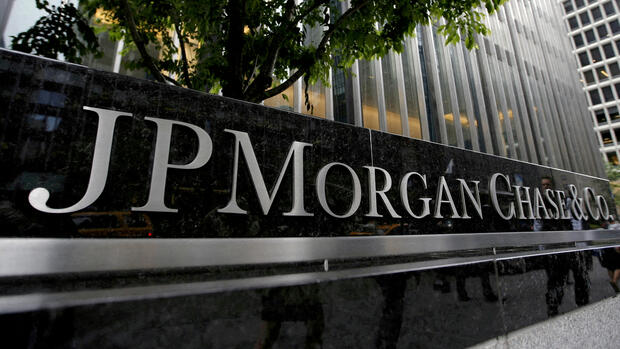new York The Wall Street institutes are entering the second half of the year stronger. America’s largest bank, JP Morgan Chase, reported record earnings on Friday, buoyed by the Federal Reserve’s high interest rates and its takeover of failed regional bank First Republic in May. Business with bonds, equities and commodities also went better than experts had expected.
“Almost all of our divisions grew in the quarter,” Bank chief Jamie Dimon said. “The US economy remains robust. Consumer balance sheets are healthy and they are spending, albeit at a slightly slower pace.”
All in all, the surplus in the three months to the end of June climbed 67 percent year-on-year to $14.5 billion (13 billion euros), the bank announced on Friday in New York. Earnings increased by a good third to $41.3 billion. JP Morgan thus beat analysts’ estimates for both stocks.
Led by longtime CEO Jamie Dimon, the bank won a government-orchestrated bidding process and won the First Republic contract. It was the second largest bank failure in US history. JP Morgan thus gained new customers, branches and deposits, from which the private customer business in particular benefited.
The largest US bank booked an immediate profit of 2.7 billion dollars. However, the institute is also preparing for higher loan defaults. Provisions in the past quarter were $1.5 billion, of which $1.2 billion related to loans from the First Republic. A year ago, the loan provision was $428 million.
Banks need to prepare for defaults
Default rates for auto loans and credit card debt have increased across the industry in recent weeks. Even as inflation falls, many Americans are suffering from the rise in prices and have largely used up their savings. The number of corporate insolvencies is also increasing. The banks must be prepared for this.
Elsewhere, inflation and the associated high key interest rates are playing into the hands of the banks: In the second quarter, JP Morgan again raised its forecast for net interest income outside of large corporate business and in investment banking in the current year.
At the end of June, net interest income was $21.8 billion – a new record and the third consecutive high. Net interest income is calculated as the difference between what banks pay on deposits and what they earn on lending rates.
The crisis in the regional banks has also helped the large institutes. Insecure customers withdrew their deposits from the smaller financial institutions and parked them with JP Morgan and Co. The large institutes are more strictly regulated and are therefore considered safer. However, they pay significantly less interest than regional banks, which supports the interest surplus.
The failure of the First Republic Bank was the second largest bank failure in US history.
(Photo: AP)
“It’s very hard to find fault with JP Morgan’s second quarter results. The results were excellent and really showed strength in all areas,” praised Octavio Marenzi, CEO of the capital market consultancy Opimas. The good result in the lending business compensated for the ongoing weakness in investment banking. Fees fell there by 6 percent to $1.6 billion. However, they were still above the expectations of the analysts.
Revenue from trading in fixed income securities and stocks fell 10 percent to $7 billion as the financial markets slowed. Investors welcomed the results. The stock rose a good one percent in the early hours of trading in New York.
Higher interest rates boost Wells Fargo’s profits
The major US bank Wells Fargo also jumped in profits in the second quarter due to increased interest payments from customers. The fourth largest US bank also raised its forecast for net interest income.
The US economy continues to perform better than many expected. Wells Fargo boss Charlie Scharf
This had increased in the second quarter compared to the previous year by 29 percent to 13.16 billion dollars. For the year as a whole, it will be around 14 percent higher than in 2022, the money house announced on Friday. Previously, it had targeted an increase of ten percent. The San Francisco bank’s surplus climbed to $4.9 billion from $3.1 billion a year earlier.
The Fed has hiked interest rates at a record pace since last March, most recently to the 5.0 to 5.25 percent range. Wells Fargo also expects increasing loan defaults. Loan loss provisions in the second quarter were $1.7 billion, a good three times as much as a year ago.
Above all, the bank is preparing for turbulence in office loans, which have experienced increasing difficulties in recent months. “Overall, the losses are still quite small,” emphasized CFO Mike Santomassimo. But the bank assumes that the weak phase will last for a while. The share gained a good 1.1 percent.
Citigroup with a significant drop in profits
At the major US bank Citigroup, on the other hand, profits fell significantly due to the weakness in the trading business. Surplus fell 36 percent to $2.9 billion in the second quarter from $4.6 billion a year earlier.
Profits from private customer business and wealth management could not make up for the setback in retail. Revenues in that division fell 13 percent to $4.6 billion. One reason was the relatively low volatility, said the third largest US bank.
Citigroup was out of the ordinary with its earnings drop on Friday. The stock was down 2.1 percent. Bank of America, Morgan Stanley and Goldman Sachs will present their numbers next week. Goldman managers have recently warned that the results of the renowned Wall Street bank will be worse than initially expected. Wells Fargo analyst Mike Mayo believes this could be the weakest quarter of CEO David Solomon’s tenure.
With agency material
More: Why Wall Street banks are anticipating troubled times
